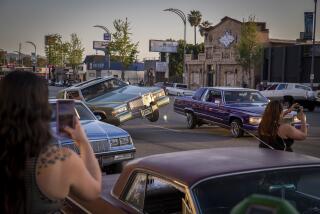Classic Cars Pose Special Risks for Drivers
- Share via
We all know the drill. The first thing you do when you slide behind the wheel is buckle up for safety. If you don’t, you risk getting a ticket that could cost you as much as $271.
So what’s up with all these vintage car owners who cruise around Southern California sans seat belts? How safe is that?
Not a day goes by that I don’t see someone zipping around in a vintage automobile--a ‘50s-era Cadillac or a dilapidated Volkswagen Beetle from the ‘60s.
Recently I pulled up next to a slick ’55 Chevy carrying a group of teenagers. No one appeared to be wearing a seat belt--certainly a cause for alarm.
But because the car was manufactured before the 1964 federal law requiring factory-installed seat belts, no safety restraints are required.
Under the law, owners of classic cars are not required to install safety belts or shoulder harnesses if they were not original equipment on the vehicles, said Kim Hazelbaker, senior vice president of the Insurance Institute for Highway Safety in Arlington, Va.
Safety-conscious owners, such as Bob Ford, 60, of Villa Park, who also drives a ’55 Chevy, have voluntarily added the safety equipment. But chances are the owner of that other Chevy, with its carload of teenagers, did not.
Stephanie Tombrello, executive director of SafetyBeltSafe USA, said driving without seat belts, especially in a vintage car, is putting your life on the line.
“Anyone riding around in a classic car without belts is at major risk if they get into an accident.... The older the car, the less forgiving it will be in an accident,” said Tombrello, whose nonprofit national group, based in Torrance, advocates strong seat-belt and child car-seat safety laws.
Even car buffs are split about whether safety should prevail over retaining their vehicles’ original state.
The use of seat belts is a civil liberties issue, one colored by the fact that some early retrofitted seat belts “weren’t the safest,” said McKeel Hagerty of Hagerty Classic Insurance, an agency that insures vintage vehicles.
“If you owned a car from the ‘30s and wanted to win a car show, you wouldn’t put seat belts in it, because you could lose points from the judges,” Hagerty said.
But today, he said, there is a new generation of collectors who are more concerned about the safety of their passengers than winning shows.
Still, said Ford, who writes a newsletter for owners and fans of 1955-57 Chevys, he knows of car buffs who neglect to install belts to secure their children. Some simply believe that any modification to a classic car is bad, he said.
Seat-belt laws vary among states. But in California, the law that exempts classic cars from having seat belts applies to adults, not children. State traffic safety regulations dictate that children younger than 6 or who weigh less than 60 pounds must be secured in a booster seat or child safety seat even if they are in a vintage vehicle, said Anne DaVigo, a spokeswoman with the California Highway Patrol in Sacramento.
California is one of 18 states in which police can stop vehicles if they suspect seat-belt noncompliance. In 31 states, police can issue a seat-belt ticket only if they discover the violation during a stop for another offense. New Hampshire doesn’t have a seat-belt law.
Longtime enthusiasts say an increasing number of teenagers and young adults are restoring and driving older vehicles because they can be fairly inexpensive to acquire.
But allowing inexperienced teens to drive some of these vintage cars is risky, safety advocate Tombrello said.
“I would question the parents permitting their children to make that choice,” she said. “Look at the crash involvement with teenagers. You are asking a relatively inexperienced driver out in complicated traffic to maneuver a vehicle that does not have the latest safety equipment. You are setting the stage for a more perilous outcome.
“Motor vehicle crashes are the No. 1 cause of death and injury in children and young adults, and it has been that way for years. Sixty percent of children who die in car crashes are unrestrained.”
It also should be noted that vintage vehicles generally lack other safety features that we take for granted in newer cars and trucks, such as air bags, anti-lock brakes and reinforced crumple zones.
“These cars are beat. There is usually more rust than metal,” Teri Olcott wrote on her vintage-car Web site, www.vintagecars.about.com.
“The tires are bald, the exhaust is hanging, bumpers are missing, and often doors, hoods and trunks are wired or taped closed.... If you are the parent of a driving teenager ... take a good look at what your beloved child is driving.”
Jeanne Wright cannot answer mail personally but responds in this column to automotive questions of general interest. Please do not telephone. Write to Your Wheels, Business Section, Los Angeles Times, 202 W. 1st St., Los Angeles, CA 90012. E-mail: jeanrite@aol .com.






